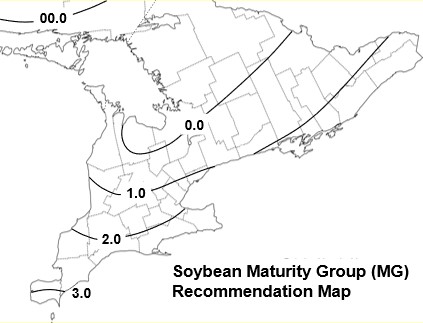Soybeans are a photoperiod sensitive crop, meaning they flower based on the number of hours of sunlight in a day as well as temperature. Genetics, temperature, and hours of sunshine all play a role in when soybeans begin to flower and how fast they will mature in the fall. Soybeans typically begin flowering at the fourth to sixth trifoliate growth stage, shortly after the summer solstice on June 21st, as the days get shorter. Since hours of sunlight is not the only trigger for flowering, plants may also begin to flower well before June 21st if they are planted early. Longer season varieties (higher maturity group) are more photoperiod sensitive than short season varieties (lower maturity group). Depending on when plant stresses occur, days to maturity can lengthen or shorten due to diseases, moisture stress, and overall growing conditions.
Soybean varieties cannot be categorized simply by the number of days they take to mature since that can change, depending on where they are grown and the planting date. Instead, varieties are classified using a relative maturity system which compares new cultivars to established cultivars. In North America, there are 13 maturity groups (MG) which range from the earliest (MG 000) to the latest (MG X). In Canada, maturity groups range from MG 000 to MG III. With the use of decimals, each decimal unit is approximately equal to one day of maturity. For example, a cultivar rated MG 1.5 will mature 5 days later when compared to a cultivar rated MG 1.0 planted on the same day at the same location.
Select a variety that corresponds to the MG for the area using Figure 1, Ontario Soybean Maturity Group (MG) Recommendation Map. Generally, these varieties are called “full season” or “adapted” for a given growing region. These varieties are adapted to mature in early fall, given a normal planting date. Selecting the proper variety will provide the opportunity to make use of the full growing season, maximizing yield. It’s important to know that planting a shorter season variety (lower MG) than adapted has less yield potential because it will mature too quickly in the fall. Conversely, a variety that is too long (high MG) for a given growing area may not finish before a killing frost. A variety can only “adjust” to the season or growing region a limited amount due the photoperiod affect. The Ontario Soybean Maturity Group (MG) Recommendation Map provides a general maturity guideline to optimize soybean yield potential. This map is based on the current varieties grown in the Ontario Soybean Variety Trials. Not all varieties available for sale in Ontario are tested in these trials. Planting date, individual variety characteristics, field elevation, soil type, desired harvest date, and other local parameters must also be considered. For example, when planting early, a higher MG may yield more. Conversely, when planting extremely late (past the production insurance deadline) or in a double crop situation, a lower MG is recommended.

Figure 1. Ontario Soybean Maturity Group (MG) Recommendation Map
Winter Wheat Following Soybeans
Winter wheat often follows soybean harvest in Ontario. The dilemma in choosing a variety is between balancing a high-yielding soybean variety, with a variety that has an early harvest date. Early planting is an important management tool to maximize winter survival and high yields, see Factsheet, Winter Wheat Planting Date. The ideal planting date map for winter wheat can be used to estimate the correct soybean MG to achieve a given soybean harvest date.
If winter wheat is to be grown following soybeans:
- If conditions permit, plant the soybean crop early, as late plating will delay wheat planting. If planting occurs in early May, the selection of a shorter season (lower MG) variety is less important.
- Select a variety that is approximately 0.5-1.0 MG less than the adapted MG for your area.
- Research has shown that selecting a variety that is 0.5 MG less than a producer’s MG zone, advances the maturity by an average of 5 days (range: 3-7 days), while selecting a variety that is 1.0 MG less, advances maturity by 9 days.
- The wheat planting date can be calculated using the soybean planting date and days to maturity of the soybean variety. Days to maturity are reported in the soybean performance trials, see gocrops.ca. Days to maturity are influenced by a number of factors including planting date.